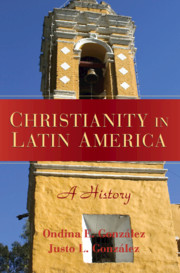Book contents
- Frontmatter
- Contents
- Preface
- Introduction
- 1 Foundations
- 2 The Arrival of Christianity
- 3 The Shaping of the Faith
- 4 Reform Movements
- 5 The Church in Turmoil
- 6 The Church's New Place
- 7 Protestant Immigration
- 8 An Expanding Protestant Presence
- 9 Catholicism after Vatican II
- 10 Pentecostalism and Autochthonous Movements
- 11 By Way of Conclusion
- Some Suggestions for Further Reading
- Sources Referenced
- Index
4 - Reform Movements
Published online by Cambridge University Press: 05 June 2012
- Frontmatter
- Contents
- Preface
- Introduction
- 1 Foundations
- 2 The Arrival of Christianity
- 3 The Shaping of the Faith
- 4 Reform Movements
- 5 The Church in Turmoil
- 6 The Church's New Place
- 7 Protestant Immigration
- 8 An Expanding Protestant Presence
- 9 Catholicism after Vatican II
- 10 Pentecostalism and Autochthonous Movements
- 11 By Way of Conclusion
- Some Suggestions for Further Reading
- Sources Referenced
- Index
Summary
As we have seen, in the sixteenth and seventeenth centuries the Spanish church in America struggled to find its place. Positions varied from that of Don Felipe Guaman Poma de Ayala, who suggested that the king let the “true Christians” – the Indians – govern in the Indies, to that of Fray Francisco de Avila, who zealously tried to eradicate any vestiges of indigenous religions in the Andes. Indeed, even as the ecclesiastical authorities made herculean attempts to impose hegemony and homogeneity over religious practices through the expansion of monastic orders, systems to increase the number of clergy, and the establishment of institutional structures, the church itself was giving birth to something uniquely American through its cofradías, its home-grown saints, and its truly interesting characters.
In Chapter 3 we discussed the impact of the realities the church encountered in the Americas, but there were other forces exerting pressure on the church as well. The eighteenth century brought cataclysmic changes to the European continent, and the church in the Indies was not immune to those. In fact, the effect in the Americas of the transformations occurring on the continent was such that ultimately the colonies would seek their independence, severing the church's close connection with the Iberian crowns. Many of the patterns that characterized the Latin American church's relationship with the Spanish or Portuguese crown would simply be transferred to the newly minted independent states – at least initially.
- Type
- Chapter
- Information
- Christianity in Latin AmericaA History, pp. 104 - 130Publisher: Cambridge University PressPrint publication year: 2007



